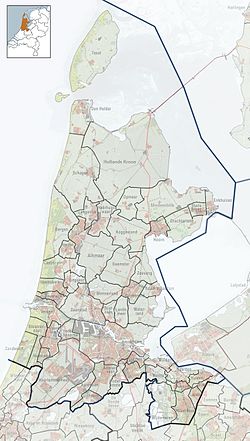Egmond-Binnen | |
|---|---|
Village | |
 Historic farm near Egmond-Binnen | |
| Coordinates: 52°36′N 4°39′E / 52.600°N 4.650°E | |
| Country | Netherlands |
| Province | North Holland |
| Municipality | Bergen |
| Area | |
| • Total | 10.52 km2 (4.06 sq mi) |
| Elevation | 3.0 m (9.8 ft) |
| Population (2021)[1] | |
| • Total | 2,515 |
| • Density | 240/km2 (620/sq mi) |
| Time zone | UTC+1 (CET) |
| • Summer (DST) | UTC+2 (CEST) |
| Postal code | 1935[1] |
| Dialing code | 023 |
Egmond-Binnen (Dutch pronunciation: [ˌɛxmɔndˈbɪnə(n)]) is a village in the Dutch province of North Holland. It is a part of the municipality of Bergen, and lies about 8 kilometres (5.0 mi) southwest of Alkmaar.
History[edit]
The village was first mentioned in 922 as Ekmunde. The etymology is unknown.[3] The missionary Adalbert of Egmond founded a chapel near Egmond-Binnen and died there around 740. In 922, the Benedictine Egmond Abbey was founded at the location and a settlement developed around it. The abbey was plundered and partially destroyed in 1573.[4] The loot was used to finance the founding of Leiden University.[5]
René Descartes lived in the village during the 1640s.[6]
In 1789, the south tower collapsed, and the remainder was sold for demolition.[4]
The Dutch Reformed church was built in 1836 at the former north tower of the abbey. Between 1914 and 1956, the church was built and a tower was added. In 1933, a new monastery was built in Egmond-Binnen and elevated to abbey in 1950.[5]
Egmond-Binnen was home to 915 people in 1840. It was a separate municipality until 1978, when it merged with Egmond aan Zee and Egmond aan den Hoef to form the new municipality Egmond. In turn, Egmond was amalgamated into Bergen on 1 January 2001.[7]
Gallery[edit]
-
Houses in Egmond-Binnen
-
The new abbey
-
Flowers near Egmond-Binnen
References[edit]
- ^ a b c "Kerncijfers wijken en buurten 2021". Central Bureau of Statistics. Retrieved 28 April 2022.
- ^ "Postcodetool for 1935AA". Actueel Hoogtebestand Nederland (in Dutch). Het Waterschapshuis. 24 July 2019. Retrieved 28 April 2022.
- ^ "Egmond-Binnen - (geografische naam)". Etymologiebank (in Dutch). Retrieved 28 April 2022.
- ^ a b Ronald Stenvert & Saskia van Ginkel-Meester (2006). "Egmond-Binnen" (in Dutch). Zwolle: Waanders. Retrieved 28 April 2022.
- ^ a b "Egmond-Binnen". Plaatsengids (in Dutch). Retrieved 28 April 2022.
- ^
Watson, Richard (2007) [2002]. Cogito, Ergo Sum: The Life of René Descartes (revised ed.). Boston, Massachusetts: David R. Godine Publisher. p. 255. ISBN 9781567923353. Retrieved 9 October 2023.
By 15 November 1644, Descartes was back in Holland. [...] When Descartes arrived in the United Provinces, he went almost immediately to Egmond-binnen, just two miles south of his former residence in Egmond aan den Hoef, and Egmond-binnen was his permanent residence until he left for Sweden in September 1649.
- ^ Ad van der Meer and Onno Boonstra, "Repertorium van Nederlandse gemeenten", KNAW, 2006. "KNAW > Publicaties > Detailpagina". Archived from the original on 2007-02-20. Retrieved 2009-12-03.







Well, that’s interesting to know that Psilotum nudum are known as whisk ferns. Psilotum nudum is the commoner species of the two. While the P. flaccidum is a rare species and is found in the tropical islands. Both the species are usually epiphytic in habit and grow upon tree ferns. These species may also be terrestrial and grow in humus or in the crevices of the rocks.
View the detailed Guide of Psilotum nudum: Detailed Study Of Psilotum Nudum (Whisk Fern), Classification, Anatomy, Reproduction